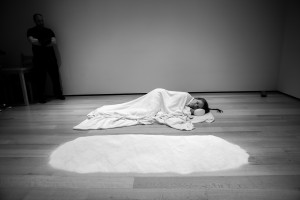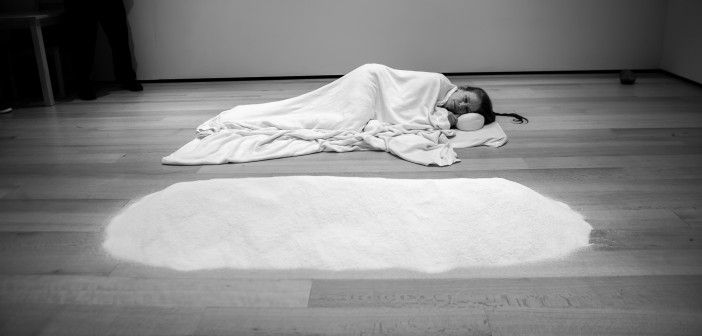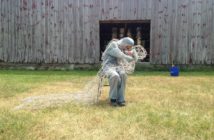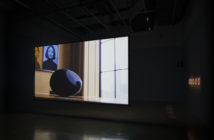Realizing durational work such as ‘100 Ways to Consider Time’ is an immense undertaking. As a part of the audience, I was able to stay with Marilyn Arsem’s performance at the Museum of Fine Arts on different days and for various durations in order to observe the work unfold from November through February. A set of challenges were present when I began to search for language to write about what the work evoked on critical, formal, aesthetic, and psychological levels. This writing will explore eight of the last fifty days of the performance, beginning from the end and working back through time.
On February 19, 2016 at 3:30pm Gallery 261 of the Museum of Fine Arts Boston was filled with an audience awaiting Arsem’s start. When she entered the space, she turned off the audio recording that described the performance of the previous day, which played from the speakers within the space. She then walked over to a large, multifaceted clock that she had assembled by hand during days fifty-two to fifty-four of the performance to adjust the weight of the pendulum so the clock would tick. After, she took a few steps to her left and shifted her focus to a calendar posted near the entrance to the space that had been there for the one hundred days of the performance; at the beginning of each performance, the text side faced the wall. She pulled off the final sheet which read ‘DAY 100’, and held the top of the sheet by her fingertips to present it to the audience before she placed it back on the wall, text side out. She then took her seat in the center of the room. Day one hundred was underway.
In the center of the space, Arsem had placed a table and two chairs. On one of the chairs was the rock that had been present during the other performances. She slowly pulled out the empty chair from the table, hovered over it, and pushed it back into place before she lowered herself to sit. The space on top of the table was covered by a bundled black cloth, which Arsem began to gently open up to reveal three long clear glass vases, nine white long stemmed tulips and three water bottles. The audience was still. There was only the sound of breathing and the ticking of the clock, which at times was faint and at other times felt mesmerizingly deafening. The cloth that held the contents was folded up and she placed it onto her lap. The three vases were positioned in a triangular formation on the table, with about a foot of space between each vessel. Arsem opened a black water bottle and filled the vases about one third full with water and then placed three tulips in each of the vases. The three water bottles were placed in a line on the floor against the left side of her chair. The flowers stuck out of the vases about six inches.
After Arsem had placed the tulips in the water and positioned them, she took a breath and revealed to the audience that the flowers would open in six hours. Immediately some audience members eyes widened and scanned the room to see if others in the audience shared their response. Others did not flinch, and were ready to spend the entire six hour duration in the space. What was noteworthy was that the audience members who were taken aback by the idea of spending this kind of time waiting were able to find a way to let it go because other people around them were willing to let go. Within the first thirty minutes of the performance, there was a core audience that remained until the last moment of the piece. I thought about the trust that the audience had that in time something would be revealed. From this moment onwards it became clear that Arsem had sought to find a way to have the audience fully experience the immense undertaking of waiting with her for changes so subtle that they could hardly be detected.
Throughout the work Arsem adjusted the water levels and temperature within the vases to control the time it would take for the opening process of the tulips to occur. The three water bottles on the floor served different purposes. One contained room temperature water, one was empty for the removal of water that had been in the vases for too long, and one held hot water, which increased the speed of the tulips opening. If the water was too hot it would have damaged the flower. Before adjusting the water she would remove the tulips from the vase and lay them down on the black cloth on the corner of the table. Arsem blended the waters to a temperature range that would nurture the opening of the tulips before placing them back inside the vase.
Arsem looked at each of the flowers individually. She placed her fingertips inside of the flowers as their blooming had become more evident to see how far along they had come. She rotated and repositioned the glass vases every so often, allowing for the opening tulips to face the audience. The movement of the flowers blooming was so slight it could hardly be quantified. However, the detection came within larger spans of time; if one had stayed in the space for a few hours rather than ten minutes it was true that the progress of the flowers opening could have been seen. Arsem looked past the flowers at audience members. About six times throughout the duration of the piece, she said to the audience: ‘We are watching them open’. There was an audio of a clock that struck on the hour every hour, rattling the space. Time felt as if it were suspended and the sound of the hours passing was a reminder that there was another time that existed outside of the room.
The constant shifting of water for the flowers felt analogous to life support. Without the water, the flowers could not have opened as quickly. Regardless, the flowers were on a timeline, and after their peak in which they would fully open it was inevitable that within a few days they would wilt, rot and dissolve. I thought of the profound way in which plants and humans are interconnected.
Moments before 9:30pm, which would mark the end of the performance, Arsem lightly pushed her chair back and stood up from the table. She walked over to the chair with the rock and picked it up. She held the rock against her stomach and stepped away from the table and began to make slow circular rotations in her footing as she moved her gaze directly at audience members throughout the room. She made three rotations, each one slower than the first which allowed for more time looking directly into the audience members' eyes. The moments that Arsem and I made eye contact I felt an immense range of emotions; I felt the past and the future, and then I was back with her in that moment when I was totally aware of my own heartbeat and anticipation for the end. When the 9:30 chime struck, Arsem addressed the audience: ‘Thank you for spending time with me.'
On day ninety-nine, Arsem laid on the floor in the center of the space with her body adjacent to a large mound of salt. The length of the mound appeared to be the same as Arsem’s height, and the mass of it seemed to be related to the weight of her body as well. A rock was present in the far corner of the space, away from the reach of Arsem, and beyond the proximity of the pile of salt. She was clothed in all white, and laid under a set of white cotton blankets with her head propped on a small cylinder pillow. The blankets were small but fitted Arsem from her neck to her feet; over time, the blankets shifted from a item reminiscent of comfort to one that evoked a sensation of suffocation.
Through the course of hours, she would adjust the position of her body between being on her back or turning onto her left side. When on her side, she would stare at the salt with tears in her eyes. A few times an hour her mouth would open and she would inhale and exhale deeply; while she did not make any noise, the strain in the breaths could be seen in the rise and fall of her chest. For the remainder of the duration, her breathing was slow, and at times it was so faint it was hardly detectable. Her eyes were what let the audience know she was still with us. Arsem’s frame was prominently visible through the blankets. When she was on her back it was reminiscent of a body at a morgue and when she was on her side, I could see the bones of her legs through the blanket which reminded me of time spent with patients in hospitals. I read the shifting between the two positions as the merging of the present and the future.
I thought about the time that it takes to die. The common assumption is that death happens swiftly, when it is actually true that death takes an excruciating amount of time and happens in multiple, complex phases. Throughout life there are deaths experienced that range from mundane to profound; and this understanding of beginnings and endings is what allows us to be conscious about what it might mean to be alive. The pile of salt was the reminder that while time in the universe might be infinite, our time is finite, and the end is encroaching.
On day ninety-five a table was positioned in the back of the gallery with a pile of black sand on it. The sand took up the entire surface of the table. For the first hour of the work, Arsem sat in a chair at the table and stared at the sand. In time, she moved her hand to the edge of the pile and began to touch the sand so that it would fall off the edge of the table and onto the floor. The sand was pushed off from the same corner, particle by particle, accumulating on the floor over time. Near the final hours of the piece, Arsem’s pace increased in speed but was still calculated in movement. The rock from previous days was revealed, buried within the black sand mound. At the end, the table was cleared, and the mound of black sand that had formed on the floor took on the same cone shape as the pile that was on the table at the beginning of the performance. I thought about the accumulation and dispersion of the particles and the way in which they came back together in different parts of space. In this case, the shift in shape resulted in a familiar form.
On day ninety-four two chairs were positioned in the center of the space side by side. Arsem sat on one chair, with a table to her left and the empty chair to her right. She was blindfolded and had her hands on her lap. When she detected footsteps of viewers coming into the gallery, she would slowly take her right hand from her lap and extend it to the seat of the chair next to her to tap on it as a way of extending an invitation for the audience to join her. When I entered the space she had a participant, so I witnessed the interaction. Arsem delicately took the woman’s hand and moved it near her nose to smell it. The physical contact between Arsem and the woman changed the experience of the work for both the participant and myself. After several moments of smelling the woman’s hand, she released it and in a notebook felt for a placement holder on the page she had saved, and began to record the scent of the woman. After she had finished making her notes, she moved her placement holder down the page, closed the notebook, left it and the pen on the table and placed her hands back into her lap. I wondered if she would remember I had entered the space since I had been sitting there silently. Before I could finish my thought she had slowly placed her fingers onto the seat of the empty chair and tapped twice for me to join her. I thought about the trust that this action required, and the power shift between Arsem and the audience members. I wanted to know what the scents recorded of the other participants were, but the log was concealed.
Day ninety-three Arsem had set up the table in the front door of the gallery space with a bowl on it filled with descriptions of actions to perform in the space. When potential audience members would approach the gallery, Arsem, who was standing in the doorway, would greet them by asking them to select a card and whether they would be willing to perform an action in the space. There were four actions that could have been selected: sitting perfectly still as long as possible, standing perfectly still as long as possible, walking across the room in slow motion, or standing and rotating once around as slowly as possible. Sitting perfectly still for as long as possible was the card that I selected. The chair was positioned off center in the room and faced another participant attempting to sit perfectly still at a slight angle. I thought about the notion of ‘perfect,’ which made me contemplate how my breathing was resulting in the rise and fall of my chest, how blinks created a rippling effect of movement across my face, and began to wonder if the internal flow of my bloodstream counted against being perfectly still. I wondered if anything in space could have ever, at any point in time, been perfectly still? Even the fabric of space itself continues to expand. I thought about the specific time and specific place in which these actions were being performed by the audience. I thought about how their memories of this night would expand the work through space and time.
Day ninety-one Arsem had set the table up in the middle of the gallery and lined it with multiple devices for keeping track of time. There were stopwatches, alarm clocks, clock audio playing from an iPhone application, hourglasses, egg timers and even a clock that was run by the acidity from a lemon. The audience was around her, both watching and hearing time run out and being reset. When an hourglass would run out she would flip it over. And then she would move her focus to adjust another timer that was going off, and then to reset a clock, and so on. This way of attempting to keep up with the devices so that they were all running together continued throughout the duration of the work. Every timer was ticking down at once. I felt all the deadlines I had missed and anxiety for the forthcoming ones I would inevitably need to pass on. The sense of forgetting something substantial, or multiple things at once came over me. Had I missed time sensitive messages that I had never responded to? Then, I thought of the heartbeat of a baby falling asleep on my shoulder, feeling my own heartbeat more with her there. Then I was listening to the beeping of a life support machine, the slowed breathing of a grandparent, the anticipation of their death and the way that seconds feel like hours in this collision of internal and external spaces. I heard sirens of emergency response, I felt the heavy sensation in my chest when brakes are slammed on to avoid an accident. I thought about impact, distance, reversing time, fast forwarding; and then I was back in the space with multiple clocks running out at once. Each tick of each clock contributed to an accumulative wearing down of my nerves. While audience members appeared to be able to find a way to calmly experience the work, I found myself unable to stay in the space.
On day eighty-four Arsem sat in a chair located in the far corner of the room with the rock positioned in front of her. She was wearing a black scarf over her head, a black dress and fitted black gloves. In her lap she had a pile of small stones which were held in a large black shawl. She would pick up a stone from her lap and extend her arm out, either towards the floor or outwards horizontally. There seemed to be a pattern to the way she was dropping the stones but I was unable to detect it. I was focused on the anticipation of the rocks slipping from the grip of her fingers and onto the floor. The accumulation of rocks on the floor spanned several feet out from the chair in all directions. Arsem’s body draped in black in the corner of the space was evocative of death, and the dropping of the stones akin to fate; never fully being able to know where the pieces may fall. Reminiscent of a landslide, the shifting edge of a cliff after taking a wrong step. I thought about history, specific time and places that are breaking down and being replaced. The slight impressions that the falling rocks could have made on the floor felt like evidence that something had unfolded in that space; time had passed with the falling of the rocks.
On day seventy-seven, Arsem had positioned a chair within a corner of the space. On top of the chair was a rock which held down the corner of a large sheet of black fabric that enveloped the space. While her body was covered, Arsem’s form was visible within the ripples of the fabric. Her left hand was unveiled, and alternated between her palm facing up and her palm facing down. The image was evocative of a body being consumed by the sea, or the remains discovered after the volcanic eruption in Pompeii. I thought about whether the image was supposed to evoke a sensation of appearing or disappearing. I thought about the fabric of space-time and how we are all traveling on the same interwoven continuum. The fabric was like a time capsule that was arrested within the space, and evocative of the unknown corners of our universe as well as the unknown within ourselves. I thought of the end potentially resulting in a new beginning somewhere else; an invisible quality made visible. The direct encounter of a performance like this is an experience that eludes words, beyond the descriptions of images created or my own sensations. Given the ongoing nature of an experience like this, it is probable that the conclusion was happening within the work from the first day of the performance.

‘Salt’, Day 99 in ‘100 Ways to Consider Time’, Marilyn Arsem. Photo Credit: Vela Oma




